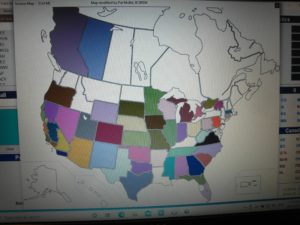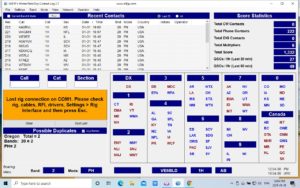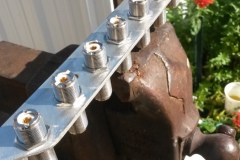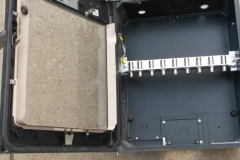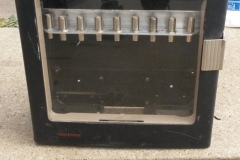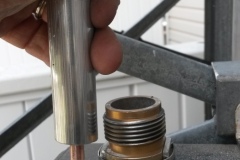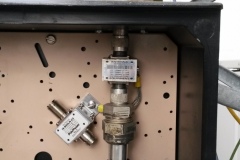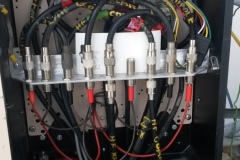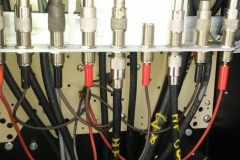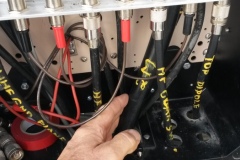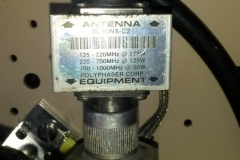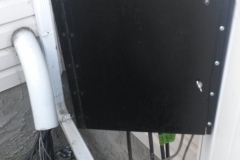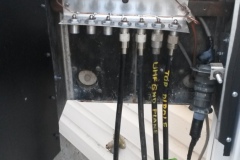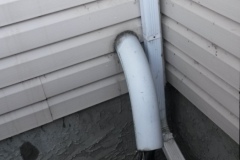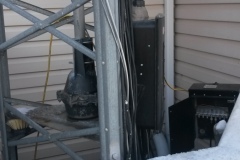- Home
- Registration
- Site Tools
- Articles
- Swap n Shop
- Contesting
- Grounding information for everyone
- History of the Central Alberta Amateur Radio Club
- CAARC owned Repeaters
- Club Repeater Info
- GMT Time Conversion Table
- VE/VA6 Incoming QSL Bureau
- Pine Lake Tornado Friday July 14, 2000.
- Amateur Radio to the Rescue
- CANWARN
- HAM Nation with Bob Heil K9EID
- Net info
- Events.
- ARES
- Links and On line study course.
- Field Day 2019
- Members D/L
- Forum/Swap and Shop
Misc

Christmas Pot Luck Supper
Nov 16th
The Annual CAARC Christmas Pot Luck Supper will be held on Sunday December 7th at 4:30PM in east Red Deer at the Bower -Kin Community place 85 Boyce Street.Please bring a food item dish and or dessert. The club will provide the turkey, ham and other fixings. If possible please bring a cash donation and or a non perishable food item for the Red Deer Salvation Army. We will meet at the hall from 4:30 PM until supper around 6:00 PM. Please bring your own cutlery and plates.
|
There will be a draw for the Gizmo also at this meeting. Please be prepared to add your personal touch to enhance this ongoing fun project.
Please click on view larger map below , then click on directions in the larger map for driving directions from your QTH
VE6BLD’s first try on an Electric Unicycle! TOO MUCH FUN!
Apr 27th
A few weeks ago I was at my son’s place in Okotoks and he helped me try his new Electric Unicycle. It was a very cold and windy day but after 3 tries I managed to go a few hundred feet! What a blast!
Click these links for my 3 best tries…
Dad’s 2nd Good Ride on Michael’s EUC This would be easier on a flat lawn with no wind!!
I may have to get one of these..
Even More CW Learning Aids
Feb 21st
As I was watching Paul VA6MPM’s very interesting Zoom presentation about Summits On The Air the evening of February 17, Ken Smith VE6AGR caught my attention by mentioning that CW is commonly used for SOTA and that he is using the internet to practice. What? Another group using CW!
I had made an earlier post to this site about the CWCOM system for practicing Morse Code via the internet, and I am interested what applications Ken is using. I got Paul VA6MPM to ask Ken on my behalf how he is practicing CW on the internet. I have edited Ken’s responding email a little, I hope without destroying his message.
The internet-based learning aid that he mentioned in the Zoom meeting is VBand which allows Practicing sending solo or sending & receiving with a few buddies, on the internet, with no embarrassment of actually transmitting on the air
Find it at https://hamradio.solutions/vband/  . You can make certain keys on your computer mimic a key or paddle but by far the best way to use this site is to buy the optional interface dongle they sell, which enables you to connect a proper iambic paddle to the computer. Some people have trouble with latency, though, so it’s not foolproof.
Other Learning Aids:
Android apps with no data connection required
For listening rather than sending practice:
Morse Machine — good tool for initially learning the characters and main punctuation signs
Morse Mentor – a next step from the above, adds prosigns & generates random-length groups of random characters. Is great for call sign practice, because you don’t get to infer things by anticipating the rest of words. Has Farnsworth timing options as well as the usual adjustable character speeds.
QSOSender3 — generates 2-minute or so messages with content from typical QSO’s – call signs, signal reports, QTH, rig info, 73 & other pleasantries, etc.
Downloadable Windows applications,
no internet connection required to actually use:
G4FON Koch Morse Trainer
Web site resources requiring an internet connection
ARRL Code Practice files (Code Practice Files (arrl.org)) – are great to practice receiving long blocks of actual text from old QST magazines. Various speeds available.
LCWO on-line (https://lcwo.net/) and Rufzxp.net seem to get good reviews in lots of places but Ken hasn’t used them. The latter apparently allows you to inflict noise and interference on yourself to really hone your skills.
Practice sending and receiving anywhere, anytime
Build the code trainer kit from QRP guys:   https://qrpguys.com/qrpguys-code-trainer Ken says, “This kit was so easy I even built one and it worked on the first try – which is something I cannot say about ANY of my other pathetic forays into electronics.†Use whatever paddle you like with this tiny keyer kit (great for travel):
Ken wishes us good luck with our CW learning exercises.
Thanks to Ken Smith VE6AGR for all this information!
John VA6SJA
RAC Canada Day Contest
Feb 3rd
I just received this in my in box today!
VE6BLD RAC Canada Day Contest 2020Winter Field Day Fun VE6BLD
Jan 31st
I spent about 6 hours Sat and Sunday working the Winter Field Day. The bands were good until after 9 Saturday night. I slept in Sunday till 9:30 but managed a lot more contacts till noon.
Here are my results.
51 Sections, 38 States, 222 contacts, 1320 points,
80m, 40m, 20m, 15m, 6m, 2m.
I hope to see some more results from others here.
Bob VE6BLD

VE6BLD’s solar pop can heater to warm your shack from the sun.
Nov 11th
In 2014 I found a video on you tube of a man in Newfoundland who had built a solar pop can heater. I decided I would build one for my big shop in the back of my large town lot. There is a south facing wall to install it on a foot away from the wall for safety reasons as it can produce 80 -90 degree C! I had an old double pane window in the shop that was about 3 by 7 feet. So the project began. I also had the aluminum frame from a score clock which had been removed from a school gym which turned out to be the perfect depth to fill with rows of pop cans after being insulated with 2 inch styrofoam. The metal frame also had a perfect indentation on the front to install the double pane window. See the pictures in the link below for how I built this pop can heater. I used a small squirrel cage fan on the inlet in the garage and another one on the outlet in the garage. There is a temperature sensor 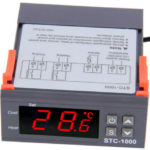 at the top of the outlet pipe connected to an adjustable digital temperature control ($8.00 on ebay). I can set any temperature to turn on the fans and I can also adjust the differential to turn off. As soon as the sun comes up and shines on the heater it will quickly come to the set temperature I programed of 32 C. The heater was tested to produce up to +180 degrees F (+80 degrees C) before I installed the fans. This is a good reason to have 2 fans so it will not melt the heater if one fan quits! Today Nov 11, 2020 the sun was very low (temperature – 12 degrees all day) but the heater quickly rose to +32 C and the thermostat turned the fans on. The heater produced a steady +18 C temp into the garage all day until there was no more sun shining on it. ! Darn nice free solar heat.
at the top of the outlet pipe connected to an adjustable digital temperature control ($8.00 on ebay). I can set any temperature to turn on the fans and I can also adjust the differential to turn off. As soon as the sun comes up and shines on the heater it will quickly come to the set temperature I programed of 32 C. The heater was tested to produce up to +180 degrees F (+80 degrees C) before I installed the fans. This is a good reason to have 2 fans so it will not melt the heater if one fan quits! Today Nov 11, 2020 the sun was very low (temperature – 12 degrees all day) but the heater quickly rose to +32 C and the thermostat turned the fans on. The heater produced a steady +18 C temp into the garage all day until there was no more sun shining on it. ! Darn nice free solar heat.
Click the pictures in the gallery
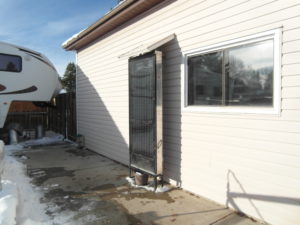
Click this link to see the picture gallery of this project
VE6BLD multi-coax junction box on my tower
Oct 16th
I have just completed building and installing a multi-coax junction box on my tower. I have 9 coaxes coming down the tower and feeding through a 4 inch pvc conduit to the basement. Every time a thunderstorm approached I would have to go behind my operating desk in the shack and disconnect them all. Two of the lines are 7/8 inch hardline with 1/4 inch solid core center conductor. Any lightning strike would have a direct path to the shack- not great!! I had an old aluminum weather proof box which was used for a chart recorder in a town pump house. Please see the pictures for the construction and finished product. There is also another WP box three feet away to connect the coaxes from the house to a grounding bar during bad weather. The red banana plugs ground the disconnected coax coming down the tower after they are disconnected. This way there is no path for the lightning to enter the house through the coaxes.
CAARC Participation in 2020 ARRL Field Day
May 21st
Paul VA6MPM has agreed to co-chair distribution of information for CAARC members’ (and any other interested amateur’s) entries in the ARRL Field Day.
We encourage your participation in the 2020 ARRL Field Day on June 27 and 28, and your submission of your individual station score to the ARRL. The 24 hours of on-air operations start at 1800Z June 27. You may operate for any convenient part of that period.
We are going to publish what we hope are bite-sized chunks about participating in Field DayThe official ARRL Classes for one or two participants are (from easiest to hardest), choose one:
- Home station using only one of your own call signs (Class D). Another licenced household member may also use this station equipment with only one of their own call signs for a separate entry. Class D stations may not count contacts made with other Class D stations. Using emergency power for a home station changes your class to Class E and allows you to claim a bonus and also allows contacts with any Field Day Station to be counted.
- Vehicular Mobile (Class C): Stations in vehicles capable of operating while in motion and normally operated in this manner. Normally used by one operator with his own call sign.
- Small group portable (Class B) set up and operated by no more than two persons. This can be your regular equipment set up so as to operate from your back yard, and I believe, your garage if it is not your regular operating position. A variant is Class B – Battery, in which All contacts must be made using an output power of 5 Watts or less and the power source must be something other than commercial mains or motor-driven generator. Set-up must start later than 0000 UTC on the Friday (Thursday afternoon or evening local time) preceding the Field Day period. Set up your station up with an effort of a total of 24 hours or less.
In the QST Field Day results each class is listed in in its own category, so in essence, you will compete with similar stations.
We will make further posts, about:
- Which QSOs can be counted and what you have to record for each QSO,
- Point score for each type of QSO
- Multipliers and bonuses
- Reporting your score
Background, official rules, and many hints can be found at http://www.arrl.org/files/file/Field-Day/2020/2020%20Field%20Day%20Packet(1).pdf .
Comments or questions to Paul VA6MPM (find his email on QRZ.com), or John VA6SJA, va6sja@rac.ca .
John VA6SJA and Paul VA6MPM



